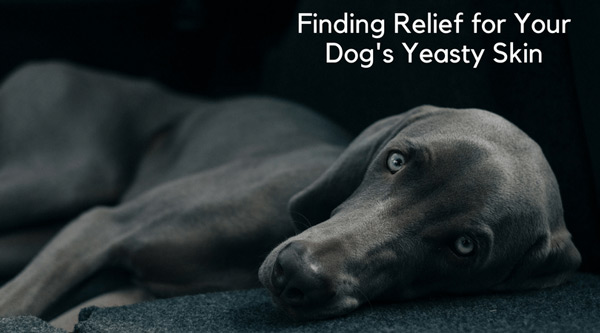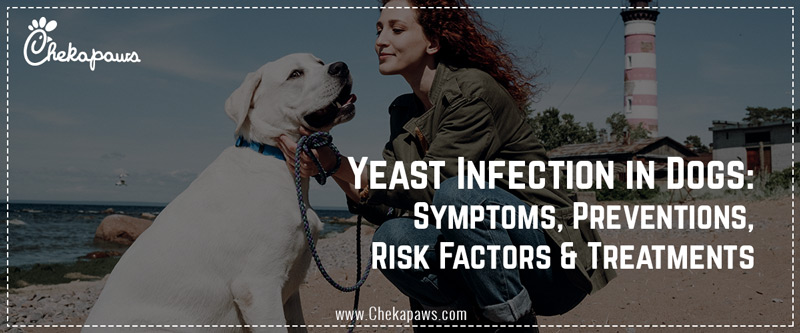After twenty-three years of practice, I’ve seen more yeast infections in dogs than I can count. From the classic “corn chip” smell of infected paws to the heart-breaking sight of a dog scratching until they bleed, Malassezia dermatitis remains one of the most frustrating conditions for both pets and their parents.
But here’s what I’ve learned: with the right approach, patience, and understanding of what we’re really dealing with, these infections are entirely manageable.
Table of Contents
What is yeast infection in dogs?
What You’re Really Fighting: Understanding the Enemy. Let me start with something that surprises many pet parents – yeast isn’t the villain here. Malassezia pachydermatis, the specific yeast that causes most canine skin infections, lives happily on every dog’s skin in small numbers.
Think of it like the bacteria in your gut – it’s supposed to be there. The problem starts when something throws off the delicate balance, allowing this normally harmless yeast to multiply out of control.
I remember Lucy, a Golden Retriever who came to me with what her owner described as “the worst smell imaginable” coming from her ears. When I looked under the microscope at a sample from her ear canal, instead of seeing the normal few yeast cells scattered around, the entire field was packed with them – like a crowded subway car during rush hour.
That’s when yeast becomes a problem. Yeast is a fungus that lives on skin and inside the intestine of your dogs. Yeast normally found on the skin but its abnormal overgrowth can cause infection.
Yeast infection is caused by under active immune system. Yeast infections are particularly common in hot, humid environment. It’s important to see the signs of yeast infection because it can cause some serious issues if not treated.
These topics may also interest you:
- Different types of cats that people have as pets
- Animal Cruelty must be completely forbidden
- How can we protect the animals in winter
The Tell-Tale Signs Every Dog Owner Should Know

- Smelly paws and licking of paws
- Ear infections, scratching of skin biting and chewing of skin
- Seasonal allergies
- Flaky skin
- Skin irritation and inflammation
- Hair loss
These topics may also interest you:
The Unmistakable Aroma
The smell is often the first thing owners notice, and once you’ve encountered it, you’ll never forget it. Some describe it as musty, others say it’s like corn chips or stale bread. I tell my clients it’s similar to the smell of wet towels left in a gym bag too long. This distinctive odour comes from the metabolic by products the yeast produces as it multiplies.
Visual Clues That Scream “Yeast”
The skin changes are equally distinctive. In early stages, you’ll see redness and inflammation, particularly in warm, moist areas where yeast thrives – between the toes, in skin folds, armpits, and around the ears. As the infection progresses, the skin becomes greasy and may develop a waxy, brownish discharge that mats the hair.
I’ve noticed that chronic cases develop what we call “elephant skin” – thick, leathery patches with dark pigmentation. This happens because the constant inflammation causes the skin to protect itself by thickening, similar to how a callus forms on your hands.
Behavioural Changes That Break Your Heart
The itching is relentless. Dogs will lick their paws raw, scratch until they bleed, and shake their heads so vigorously they can rupture blood vessels in their ears. I’ve seen dogs so consumed with scratching that they forget to eat or play. The worst part? The more they scratch and lick, the more moisture and trauma they create, feeding the very problem they’re trying to solve.
These topics may also interest you:
Why Some Dogs Keep Getting Infected (And How to Break the Cycle)
The Usual Suspects: Predisposed Breeds
In my experience, certain breeds walk into my clinic with yeast infections so frequently that I can almost predict it. West Highland White Terriers, Basset Hounds, Cocker Spaniels, and Dachshunds top my list.
These breeds often have genetic predispositions – some produce more skin oils, others have compromised immune responses to yeast, and many have structural features like deep skin folds or heavy, floppy ears that create perfect yeast environments.
I had a Basset Hound named Buster whose ears were so infected that the entire ear canal was essentially a yeast soup. His owners had been treating “ear infections” for two years before we identified the underlying allergies that were creating the perfect storm for yeast overgrowth.
The Hidden Culprits: Underlying Conditions
Here’s what many pet parents don’t realize – yeast infections are almost always secondary problems. Something else creates the conditions that allow yeast to flourish. Food allergies top my list, followed closely by environmental allergies, hypothyroidism, and immune system disorders.
The most common scenario I see goes like this: A dog develops food allergies, which cause skin inflammation. The inflamed skin produces more oils and becomes more hospitable to yeast. The yeast multiplies, causing more inflammation, which attracts more yeast – it’s a vicious cycle that can continue for years if the underlying allergy isn’t addressed.
These topics may also interest you:
My Diagnostic Approach: Getting to the Root
The Magic of Cytology
The single most valuable diagnostic tool in my arsenal is skin cytology – examining skin cells under a microscope. It takes me less than five minutes, costs very little, and gives me immediate answers. I can see exactly what we’re dealing with: yeast cells that look like tiny footprints or peanuts under the microscope.
What I’m looking for is more than five yeast organisms per high-power field, or any yeast in areas where they shouldn’t be abundant. This simple test prevents me from treating bacterial infections with antifungals or vice versa – a mistake that can waste weeks of treatment time and your money.
The Detective Work: Finding the Underlying Cause
Every yeast case gets the same workup in my practice. We check thyroid function, look for food allergies through elimination diets, and evaluate for environmental allergens. I’ve learned that treating just the yeast without addressing the underlying cause leads to endless recurrences and frustrated owners who think their dog is “just prone to infections.”
These topics may also interest you:
- Surprising flea facts for dogs and cats
- Why Dogs are Man’s Best Friend?
- What to Expect When You’re Expecting a New Puppy: A Guide for First-Time Owners
Treatment Strategies That Actually Work
The Foundation: Topical Therapy
Medicated shampoos containing ingredients like miconazole, chlorhexidine, or ketoconazole form the backbone of my treatment approach. I prefer combination shampoos that fight both yeast and bacteria, since secondary bacterial infections are common.
The key is frequency – I typically recommend bathing every 3-5 days initially, allowing the shampoo to sit for 10-15 minutes before rinsing.
Here’s a pro tip I share with every client: think of these medicated baths as delivering medicine to the skin, not just cleaning your dog. The contact time matters more than the scrubbing action.
When Oral Medications Become Necessary
For severe or widespread infections, I prescribe oral antifungals like ketoconazole or itraconazole. These medications work from the inside out, reaching areas that topical treatments might miss.
However, they require liver monitoring, and I always explain the potential side effects to owners. Most dogs tolerate them well, but I’ve seen enough cases of liver enzyme elevation to take these medications seriously.
The Home Care Game-Changers
I’m a big believer in empowering owners with effective home care strategies. Apple cider vinegar rinses, diluted 50:50 with water, can help restore the skin’s natural pH and make it less hospitable to yeast. I’ve had excellent results with this simple remedy, especially for mild cases or as maintenance therapy.
Coconut oil is another favourite – its natural antifungal properties, particularly the caprylic acid content, can help control yeast while moisturizing irritated skin. I recommend applying small amounts to affected areas after they’ve been cleaned and dried.
These topics may also interest you:
- How to Introduce Your Cat to Other Pets
- 10 Surprising benefits of having a cat in your life
- Common health problems in cats and how to prevent them
The Dietary Connection: Starving the Yeast
The Carbohydrate Trap
One of the most important conversations I have with owners involves diet. Yeast thrives on sugars and simple carbohydrates, and many commercial dog foods are loaded with exactly these ingredients. Corn, wheat, rice, potatoes – all of these break down into sugars that can feed yeast overgrowth from the inside out.
I remember a chronic case – a Shih Tzu named Pepper who had been battling yeast infections for three years. Within six weeks of switching to a grain-free, limited ingredient diet, her infections cleared for the first time in years. Her owner was amazed, but I wasn’t surprised – I’d seen it countless times before.
What I Recommend Instead
I advocate for high-protein, low-carbohydrate diets for yeasty dogs. Fresh, whole foods are ideal, but high-quality grain-free kibbles can work too. The key is avoiding foods high in starches and sugars while providing the nutrients needed for healthy skin and immune function.
Probiotics deserve special mention – I recommend them for nearly every yeast case. Restoring healthy gut bacteria helps rebalance the entire body’s microbiome, making it less susceptible to yeast overgrowth.
These topics may also interest you:
- 10 Common Health Issues in Hamsters and How to Treat Them
- Why Hamsters Are The Best Small Pets For Kids
- The Benefits of Adopting an Older Dog – Give Them a Second Chance
Prevention: The Best Medicine
Diet Control
Remove all sources of sugar in dog’s diet. Diet high in sugar is the main cause of yeast infection as yeast needs sugar to live. So if you remove carbs and sugar from your dog’s diet, you can starve the yeast. We should not feed carbs or grains to dogs as it can worsen their infection.
Avoid foods which contain carbohydrates like potatoes, corn, wheat, rice, honey, peas. These food can trigger the allergies in pets as they contain sugar. This step is actually really important because you can’t effectively deal with the yeast problems without addressing this aspect of your pets’ diet. So cutting of the sugar from diet is important.
Treatment for controlling yeast
Yeast infections are a common skin concern for dogs, causing itching and irritation so they need to be controlled by using the right products and medications. Apply natural topical shampoos on dogs focus more on the infected areas. Add anti fungal foods in diet like coconut oil for reducing yeast.
It’s not just enough to apply any anti fungal cream or lotion to those parts of the body, the parts of the body which have yeast infection must be disinfected. Coconut oil is best for curing yeast infection.
Environmental Management
Moisture control is absolutely critical. I tell owners to think of yeast like mushrooms – they both love dark, damp places. After baths, swimming, or walks in wet weather, thorough drying is essential. Pay special attention to areas between toes, in skin folds, and inside ear flaps.
I recommend keeping affected areas as dry as possible. For dogs with chronic ear issues, I suggest using cotton balls in the ears during baths and blow-drying ears on cool settings after swimming.
Regular Maintenance Routines
Prevention requires consistency. Weekly ear cleaning with appropriate solutions, regular grooming to prevent hair matting in fold areas, and maintaining good overall hygiene all play roles. I also recommend regular “yeast checks” – quick examinations of problem areas so you can catch issues early.
These topics may also interest you:
- 10 Reasons Why Dogs Make the Best Pets – Adopt a Dog Today
- How to protect pet dogs, cats and strays from heat wave
- 10 Tips for Traveling with Your Dog: Making Trips Hassle-Free
When to Worry: Red Flags That Need Immediate Attention
Some situations require urgent veterinary care. If you see spreading redness, open wounds, signs of systemic illness (lethargy, loss of appetite, fever), or if your dog seems truly miserable, don’t wait. I’ve seen ear infections progress to ruptured eardrums and skin infections lead to serious secondary bacterial complications when left untreated.
These topics may also interest you:
- How to Introduce a New Cat to Your Home
- 10 Pet Animals For Emotional Support
- Types Of Pet Allergies and How to Treat Them
Long-Term Success: Managing Chronic Cases
The Reality Check
I need to be honest – some dogs will always be prone to yeast infections. Dogs with severe allergies, certain genetic predispositions, or immune system issues may need ongoing management rather than cure. This doesn’t mean failure; it means adapting expectations and developing sustainable long-term strategies.
Success Stories That Give Me Hope
I think of Max, a West Highland White Terrier who came to me as a puppy with severe yeast dermatitis. His owners committed to the comprehensive approach – addressing his food allergies, maintaining strict hygiene protocols, and following up regularly. Today, at eight years old, he has occasional mild flare-ups that respond quickly to our established protocol. His quality of life is excellent, and his owners know exactly what to watch for and how to respond.
These topics may also interest you:
- Why I Started This Blog Page?
- 10 Ways to Get Involved with Pet Owners in Your City
- How to educate people and children about animal welfare
Your Action Plan: Getting Started Today
Week One: Assessment and Immediate Relief
- Schedule a veterinary appointment for proper diagnosis and cytology
- Begin gentle cleaning of affected areas with appropriate solutions
- Start photographing affected areas to track progress
- Begin a symptom diary noting itching frequency, odour intensity, and affected areas
Week Two-Four: Implementing Treatment
- Follow prescribed medication schedules religiously
- Begin medicated baths at recommended frequency
- Start dietary modifications if recommended
- Continue monitoring and photographing progress
Month Two and Beyond: Long-term Management
- Work with your veterinarian to identify and address underlying causes
- Develop a maintenance routine based on your dog’s specific needs
- Learn to recognize early warning signs of recurrence
- Create an emergency action plan for flare-ups
These topics may also interest you:
- What are the conditions needed to become a foster parent for cats and dogs?
- How to Cope with Losing Your Pet
- Indoor vs. Outdoor Cats Pros and Cons
Final Thoughts: Hope and Realistic Expectations
Yeast infections can be incredibly frustrating, but they’re not insurmountable. I’ve seen countless dogs go from miserable, stinky, itchy messes to comfortable, happy pets with the right approach. The key is understanding that this is rarely a quick fix – it’s about understanding your individual dog’s triggers, committing to proper treatment protocols, and maintaining realistic expectations about management versus cure.
Remember, every dog is different. What works for one may not work for another, and finding the right combination of treatments, dietary modifications, and environmental controls may take time. But with patience, persistence, and proper veterinary guidance, the vast majority of dogs with yeast infections can live comfortable, happy lives.
The most successful cases I see have one thing in common: owners who understand they’re in this for the long haul and are willing to be partners in their pet’s care. With that commitment, yeast infections become just another manageable aspect of pet ownership, not a source of endless frustration and worry.
These topics may also interest you:
- Senior Pet Care Tips. How to Keep Your Aging Pet Comfortable?
- The Rise of Pet Tech: How Smart Devices Are Changing Pet Care
- Homemade Pet Food: Is It Healthier Than Store-Bought?
Preventing the yeast from coming back
Some vets will tell you that yeast infection stays forever and will require medicated treatment. You should dry them properly after bath. Your pet should be damp but not dripping wet.
Keep them indoors during extreme heat and humidity. Give them good quality food and be aware of any kind of allergies.
Risk factors that increase yeast infections
Bacterial infection is common in dogs. It occurs when a dog’s immune system is weak and bacteria is able to reproduce and spread in the dog’s body.
Underlying skin disease like atopic dermatitis. Pets that develop signs of atopic dermatitis should be seen by a veterinarian as soon as possible. In this disease skin becomes very itchy. It is caused by food reactions or airborne substances.
Skin folds dermatitis is a infection in dogs. Skin folds dermatitis is common in overweight dogs, dogs with wrinkle skin. It only occur in few selected breeds of dogs.
These topics may also interest you:
- How to Socialize Your Pet: Tips for Puppies, Kittens & Rescues
- How to Create a Pet-Friendly Home Without Compromising Style
- When Should Obedience Training Be Started for Puppies?
- 5 Fun Ways to Include Your Pet in Holiday Festivities
- Why Cats Make Amazing Companions
- How to Make Your Own Dog Treats
- What to Look for When Adopting a New Cat
- 10 Fun Brain Games for Dogs
- 5 Challenges That Made Me a Better Pet Parent








Thanks fr the information vrinda